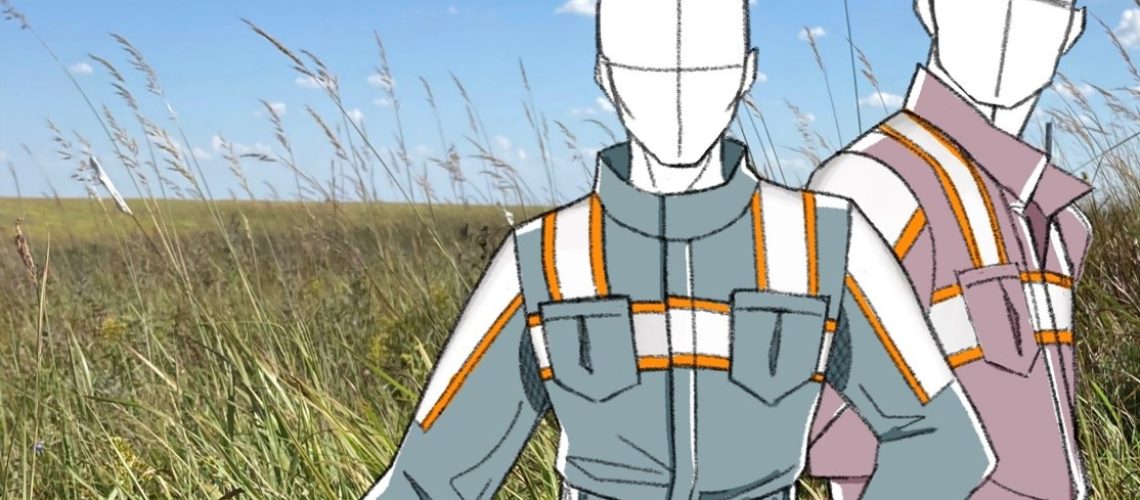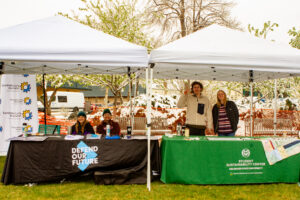Guest Post by Mary Linabury, 2022-2023 Sustainability Leadership Fellow, and Ph.D. Candidate in the Department of Biology and Graduate Degree Program in Ecology at Colorado State University
I’m a scientist, but not the type who rockets billion-dollar satellites into space, or the type that sails ocean liners laden with specialized sensors. Nope, I’m an ecologist who walks around grasslands with measuring tape, a clipboard, and a pep in my step.
Of all the scientific fields, ecology (the study of how organisms interact with each other and their environment) is likely one of the most “low-tech.” We do use some specialized tools, but most of the equipment I use during the field season is bought from hardware stores: scissors, metal stakes, PVC pipe, fencing, etc. Few tools are specifically designed with field scientists in mind, but we adapt and improvise.
For instance, I simulate rainstorms in grasslands using water pumps meant to fill swimming pools, and contain that water with dams improvised from sheets of aluminum meant for roofing. Drought has been a common topic in the news cycle, but as the climate intensifies, extreme rainstorms and flooding will also become more common. This is concerning, considering that the modern world is more “fertilized” than ever, mostly due to agricultural runoff (rich with essential nitrogen), and emissions from burning fossil fuel. Most grasslands are limited by water and nitrogen, so when fertilized landscapes are hit with extreme rainstorms, something’s gotta give—our native grasslands aren’t adapted to these conditions. Similar work has reported local loss of native species and encroachment of invasives. It’s essential that we understand how changing rainfall patterns will affect the American Great Plains, so we improvise with what’s available for the sake of science.


Caption: Here I am “working” in my two grassland sites. The shortgrass steppe (left) is an arid grassland on the western side of the Great Plains along the Rocky Mountains. The tallgrass prairie (right) is found on the opposite side of the Great Plains and receives almost triple the amount of water compared to the shortgrass steppe. That’s why they look so different—it’s all about the water.
Beyond field equipment, we also need to improvise our wardrobe. There’s plenty of outdoor gear that can fit our needs, but we deal with several unique problems that other outdoorspeople may never encounter. I conduct my work in two Great Plains grasslands, each with its own set of obstacles. Along the front range of the Colorado Rocky Mountains grows the dry shortgrass steppe. Rattlesnakes are dangerous, but at least they warn you before they strike, whereas dehydration and heat exhaustion aren’t so polite. Temperatures easily exceed 100°F and it feels like the dry air sucks moisture as quickly as you can drink it. I do my best to wear light clothes that minimize water loss from sweat, but long sleeves and pants are a necessity to avoid constant sun damage. To stay safe, we balance these needs.
On the other side of the Great Plains is the humid, lush tallgrass prairie—when the wind blows through, the grasses undulate like green ocean swells. Dehydration is also a threat, but my main adversaries are the biting insects. Tiny mites crawl into our sleeves and pantlegs, causing itching, oozing sores that can take months to heal. We also need to be wary of poppyseed-sized ticks that carry Lyme disease. I can adapt my clothes by taping my pants to my socks to keep the mites out, but this solution leads to greater risk of overheating and dehydration. Again, a balancing act is required to stay safe and comfortable.
I can adapt, though I would appreciate not needing to. It’s nice to have gear and equipment built with your needs in mind. Having specialty clothing would ease the stress of fieldwork and perhaps prevent some exhaustion I feel at the end of a long day in the grassland.
I can adapt, but I also may be able to provide a solution. I’ve been studying ecology for years, but before that, I was an aspiring fashion designer. All through high school, I designed and sewed my own clothes and then spent a few semesters in college pursuing fashion design. Although I’ve reconsidered my career path, sewing and design have remained my favorite hobby. I never imagined that my interest in sewing would overlap with my knowledge of field biology, but their combination may make my fieldwork more comfortable. So, I’ve designed the “field scientist’s uniform,” a piece of clothing that is specialized for my needs and wouldn’t require customization to be functional:

Since heat exhaustion is the greatest danger we face in the field, this design has built-in cooling features: mesh panels under the armpits and between the thighs would help evaporate sweat, and a vented back would allow cooling while not sacrificing sun protection. It may seem uncomfortable to have your skin fully covered, but trust me, a light layer to protect your skin from direct sun is unexpectedly beneficial. Also, the wrists and ankles are secured with Velcro flaps, meaning that bugs will have a harder time sneaking in. Note that the front zipper extends along the inseam, meaning that when you need to take a break to “use the bushes,” you won’t need to take off the whole suit and lose your protection.
A few creature comforts can do wonders for your mood, so I designed a few extras elements to keep field scientists happy. In the field you can usually find me sitting on the ground, or on my knees with my face in the grass, so the knees and seat are reinforced and lightly padded. High-visibility strips are also a necessity. I don’t consider visibility often, but our work is often conducted in remote areas that may be shared by hunters.
This is not a business pitch and I’m not asking you to donate to my Kickstarter. If anything, I did this for my own benefit—if anyone gets a physical copy, it will be me! But as I was designing this uniform, it reminded me of the barriers that some people face when trying to enter the biological field. Recent conversations discussing diversity and equity in science have revealed the cost of entry. Getting outfitted for fieldwork can be expensive. A single high-quality sun shirt can cost $80, and a good pair of work boots or hiking shoes can easily exceed $100. For students who are already struggling, these expenses can be prohibitive and may be intimidating enough to prevent someone from applying to their first field-based job. My peers have discussed donation boxes for field gear, but many jobs issue new workers a uniform. Why can’t ours?
Truly, a design like this with a relaxed and adaptable fit would be relatively easy to make—imagine how helpful it would be to new scientists to simply be issued an outfit like this. It would help overcome financial stress, enhance safety, and maybe even promote a sense of belonging.
For now, designing this outfit was a fun thought experiment about how fieldwork could be improved, but I plan to draft a physical prototype. If it goes well, and others agree that there is a need, maybe one day you’ll see groups of young scientists strutting around your local grasslands in their field uniforms.






